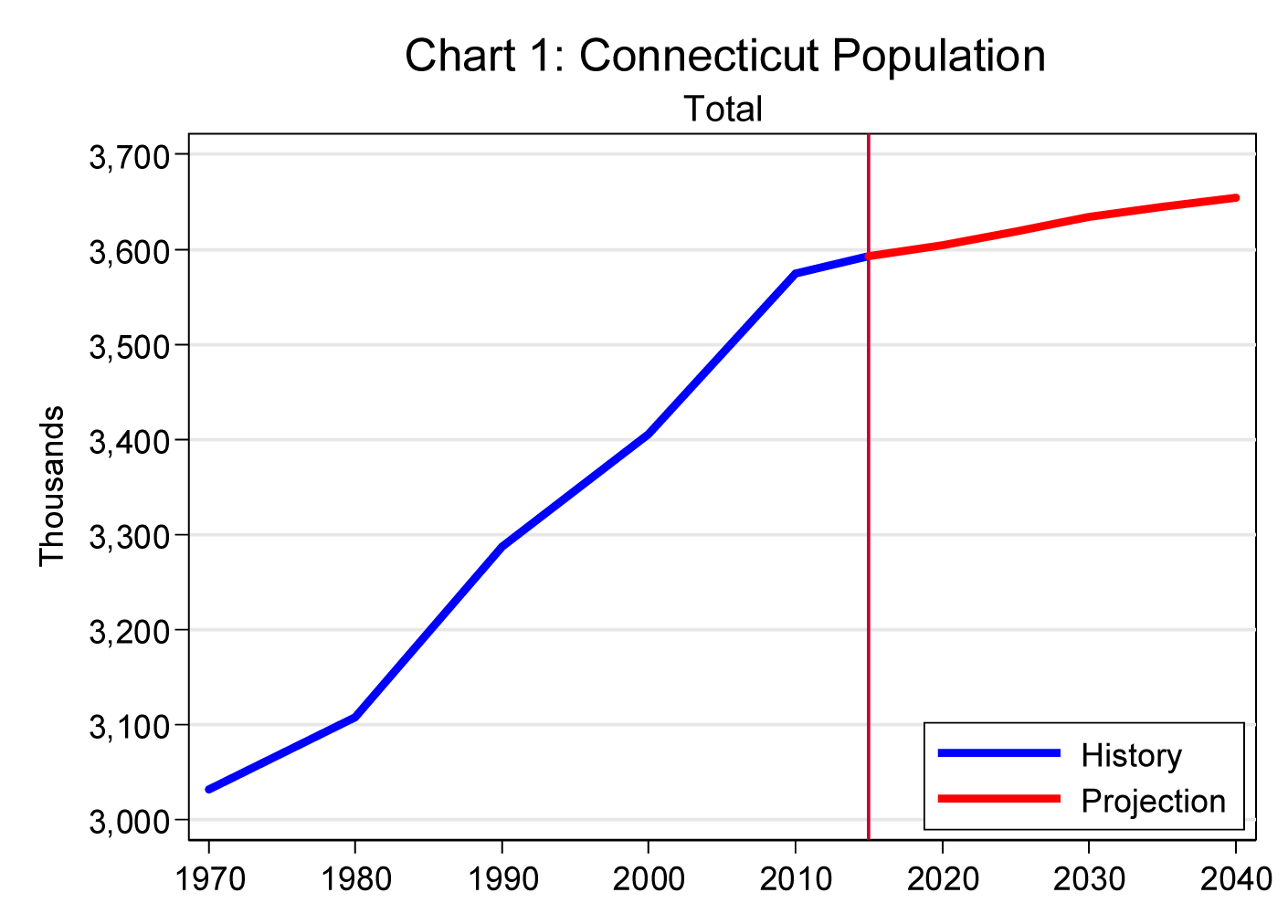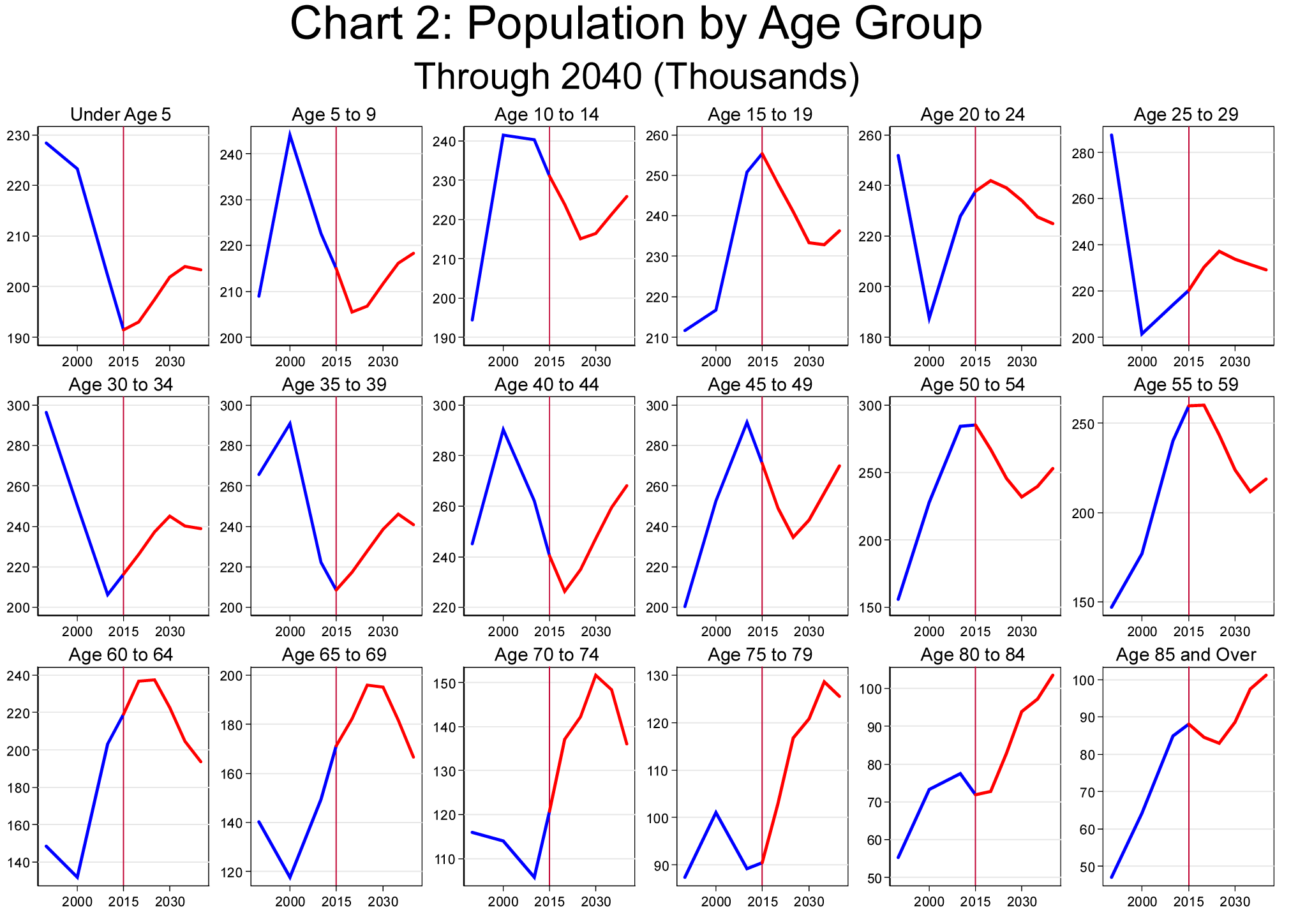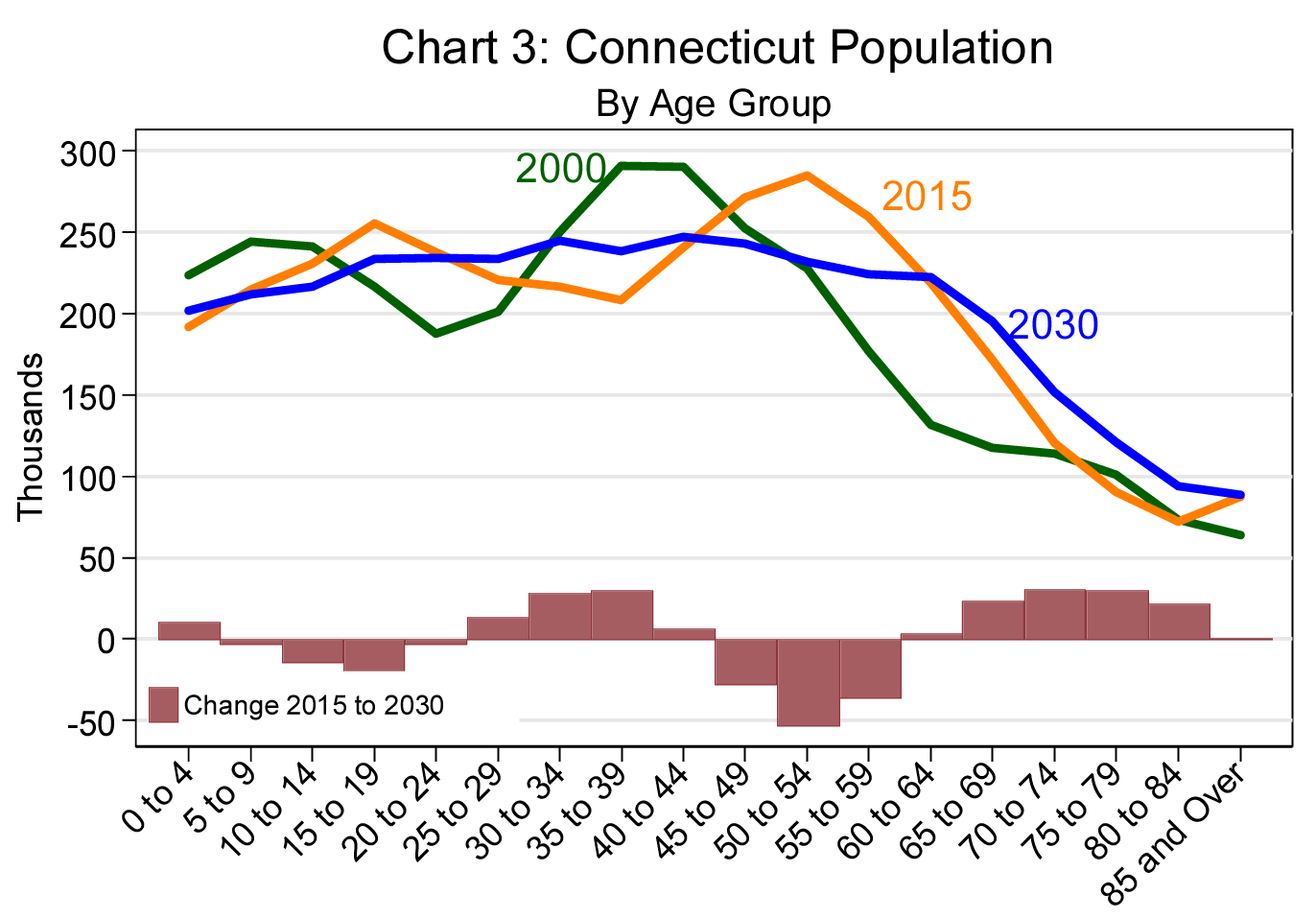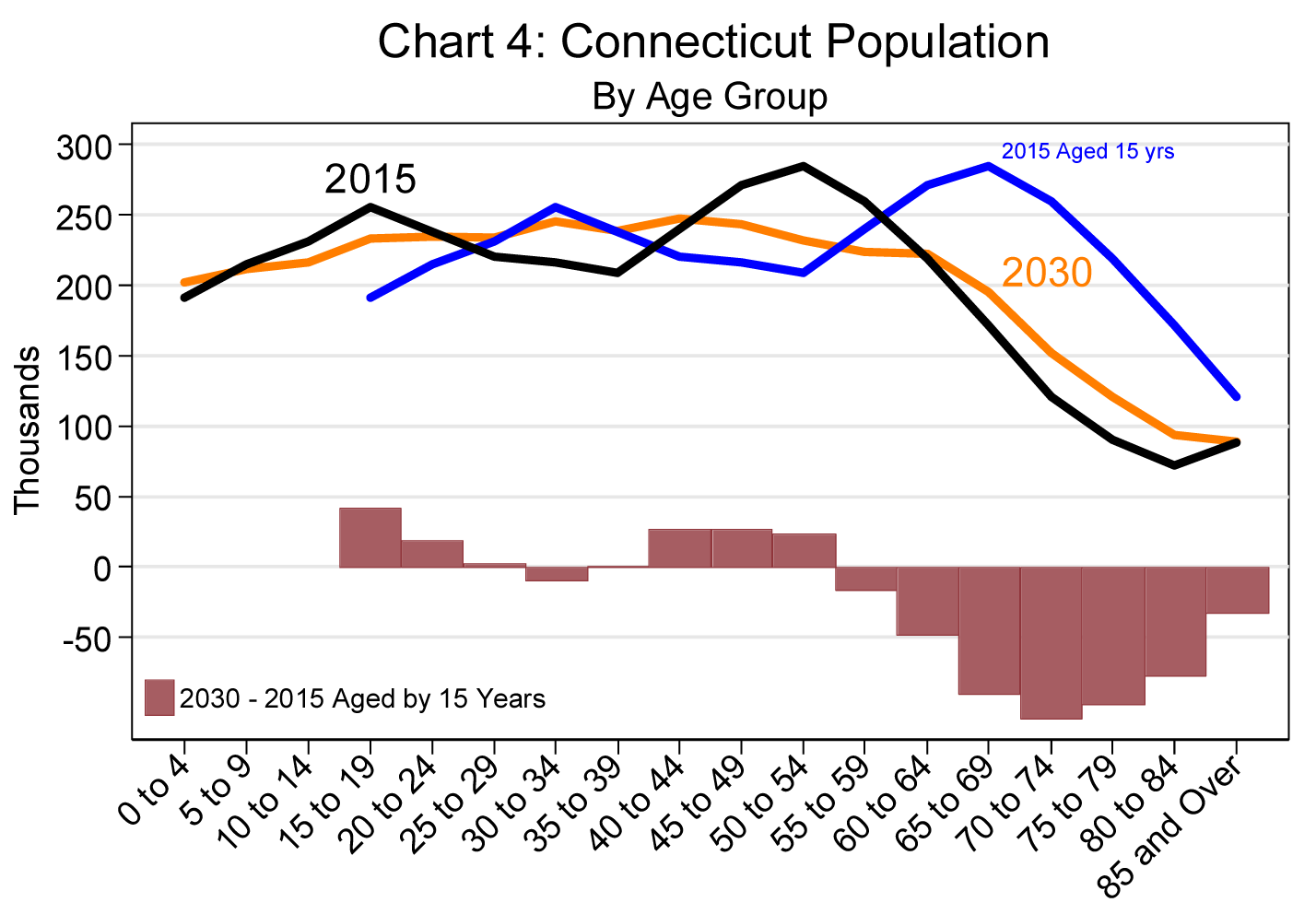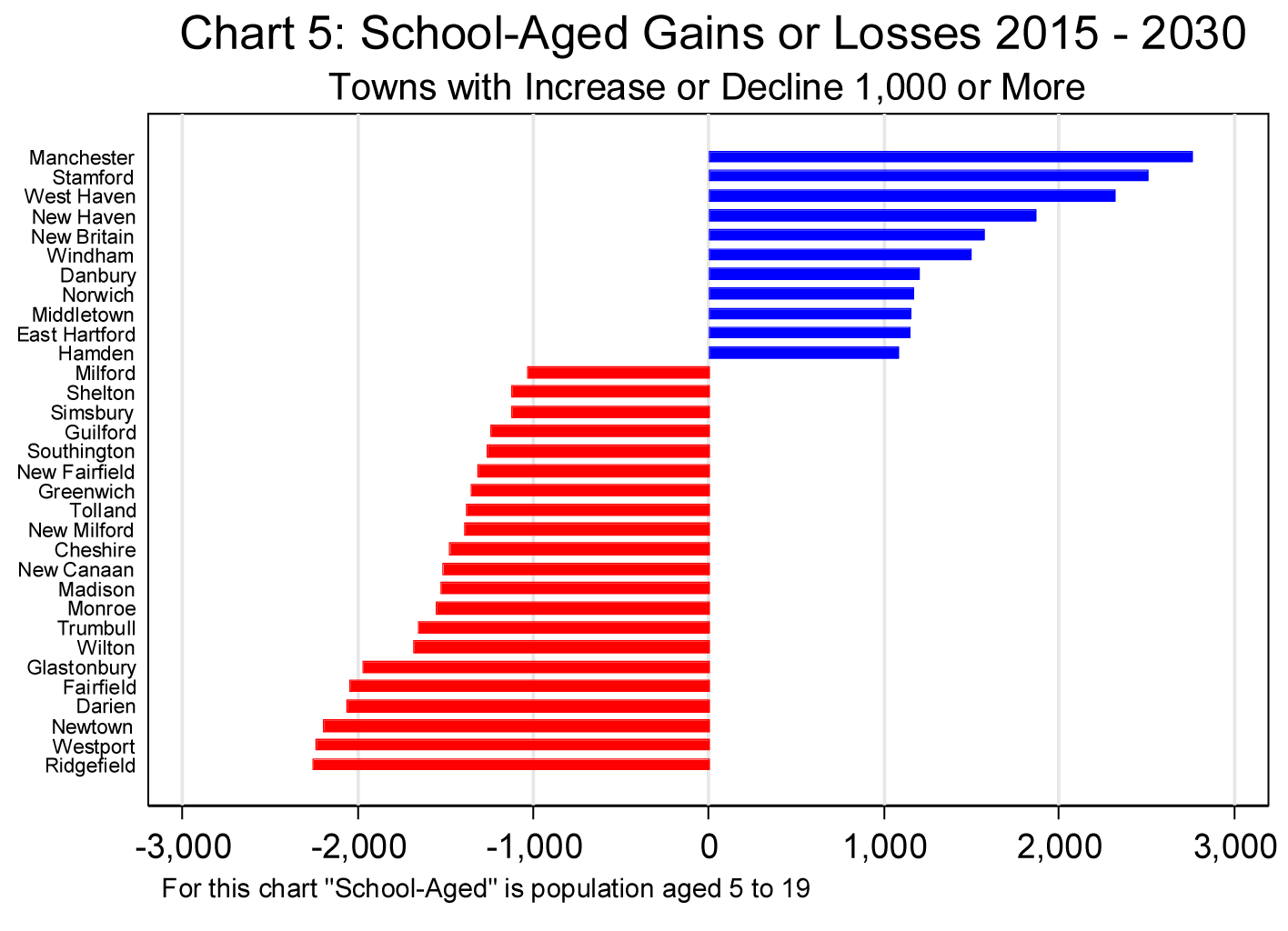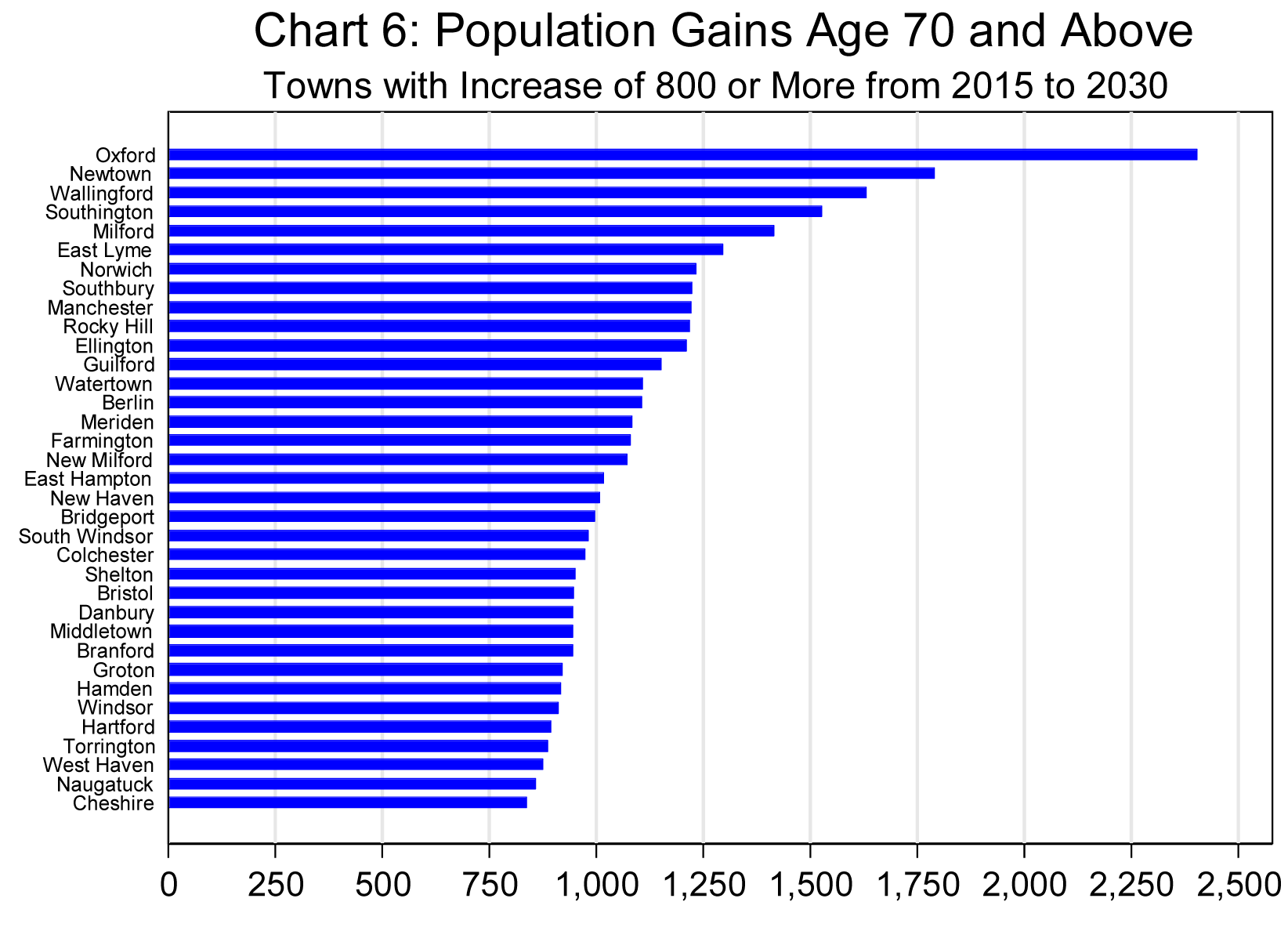
Life in the Slow Lane?
By Patrick.Flaherty, Assistant Director of Research, Department of Labor
The Connecticut State Data Center at the University of Connecticut recently released population projections for Connecticut and its towns through 20401. The projections suggest a slowing of population growth but do not show an exodus of young people from Connecticut. Declines in the younger population groups are driven by a low birth rate while migration out of state is concentrated in older age groups. Nevertheless, the number of senior citizens will increase while the school-aged population will decline. Growth with be uneven across cities and towns with some (particularly the largest cities) gaining significant population while others decline. Some of the smallest towns are projected to reverse part of the strong growth they have experienced in recent decades.
Statewide
Overview: Connecticut's population increased by over 255,000 from 1970 to 1990 and added an additional 300,000 from 1990 to 2015, a 9.3% increase (Chart 1). Population growth is projected to grow just 1.7% in the 25 years from 2015 to 2040, less than 20% of the growth rate of the previous 25 years. Focusing on the most recent 15 year period and comparing it to the next shows a similar pattern. Population grew 5.5% from 2000 to 2015 but is projected to grow just 1.1% from 2015 to 2030. While these projections are not predictions of what will happen (unforeseen events such as changes in the economy could affect these projections), they are carefully calculated projections based on fertility rates, survival rates, domestic migration, international migration, and college migration.
Age profile: The age profile of Connecticut’s population will change during the projections period. As shown in Chart 2, compared to 2015, in 2040 Connecticut is projected to have more children under age 10, people aged 25 to 44, and age 70 and over. On the other hand, there will be fewer aged 10 to 24 and 45 to 69.
Focus on 2015-2030: While the longer-term trends are of interest, many planning horizons are of shorter duration2. The rest of this article will compare the 15 years from 2000 to 2015 with the projections for 2015 to 2030. The age distribution of the population changed from 2000 to 2015 as the largest cohort aged into its 50s and beyond. There will be more changes by 2030 (Chart 3) as the number of school and college-aged (age 5 to 24) is expected to decline and the number of those mid-twenties to mid-forties is projected to increase as the “millennial” generation ages. The number of people in their mid-forties through late-fifties will decline as the last of the baby-boomers moves past age 60. Chart 4 compares the 2015 and projected 2030 populations but also includes an “Aged 2015” population – that is, a representation of what the 2030 population would look like if everyone in Connecticut in 2015 were still here in 2030 and no one died or moved in or out. Compared to the “Aged 2015” population, the 2030 projected population shows more people from age 40 to 54, but fewer people aged 55 and above. While some of this is due to natural decrease (death) the majority of the decline is due to migration to other states. For example, in 2015 the largest five-year age cohort were those aged 50 to 54. By 2030 there are projected to be more than 90,000 fewer people aged 65 to 69 than there were people aged 50 to 54 in 2015. Three-quarters of this decline is due to domestic net migration (people leaving Connecticut for other states).
1 Details about the projections including on-line data visualizations are available at http://ctsdc.uconn.edu/. Questions about the methodology for producing the projections should be directed to the Connecticut State Data Center through the above-referenced website.
Statewide
Overview: In addition to statewide projections, the Connecticut State Data Center provides population projections by age for every town in Connecticut. From 1970 to 2000, Connecticut largest cities lost population. Hartford had the largest decline (down 36,439), but Bridgeport (down 17,013), New Haven (down 14,081) and New Britain (down 11,903) all lost significant population. On the other hand, Danbury and suburban towns such as New Milford, Glastonbury, Shelton, and Southbury all gained more than 10,000 residents each with other suburban towns such as Cheshire, Guilford, Farmington, South Windsor and Southington not far behind. Since 2000 some of this trend has reversed. From 2000 to 2015 New Haven gained the most population of any city or town in Connecticut (+8,245) followed by Danbury, Stamford, Norwich, and Bridgeport (+6,313). Hartford gained more than 3,000 residents and New Britain more than 2,000. Towns that lost the most population from 2000 to 2015 were Branford, Enfield and Greenwich. When considering the towns that are projected to lose population, the Connecticut State Data Center (CSDC) emphasizes that the projections are for resident population. As noted on the CSDC website, “Resident population is defined as those persons who usually reside within a town in the state of Connecticut (where they live and sleep majority of the time). Individuals who reside in another state but either own property or work remotely in a town within the state of Connecticut are not included in these population projections.”
Looking ahead through 2030, towns expected to gain the most population are New Haven, West Haven, Manchester, Bridgeport, Norwich, and Danbury. Greenwich, Westport, Monroe, New Fairfield and Wilton will have the largest losses. The five largest cities in 1970 -- Hartford, Bridgeport, New Haven, Stamford and Waterbury -- had 60,000 fewer residents by 2000, but they have been increasing since and are projected to top their 1970 population by 2030. On the other hand, the 10 smallest towns in 1970 gained nearly 60% by 2015 but are projected to decline through 2040.
School-Aged population: Connecticut’s population aged 5 to 19 fell by just over 1,000 from 2000 to 2015 and is projected to decline nearly 40,000 by 2030. However, some towns will see an expanding school-aged population with three towns (Manchester, Stamford, and West Haven) increasing by more than 2,000 school-aged children each3. While the upper end of the 5 to 19 age group may include those no longer in school, for towns losing school-aged population the largest declines are all in the age 10 to 14 cohort. Similarly, towns gaining school-aged population, the largest increases are in the age 10 to 14 group. As noted, these are population projections, not projections of school enrollment. Nevertheless, these projections suggest there will be towns with significant increases in school-aged population even as the statewide number of people of school-age will be declining.
Senior population: Connecticut is projected to see an increase of more than 84,000 in the population aged 70 and over from 2015 to 2030. Nearly every town will see a population increase for this age group. For example, as shown in Chart 6, Oxford, Newtown, Wallingford, and Southington are projected to see the largest increases in the population aged 70 and above. The enormous increase in Oxford is a good illustration of the difference between a projection and a forecast and shows the limitations of the projections. Oxford has seen a significant number of seniors moving into town over recent decades. The models used to create the projections assume this trend will continue. A forecast (which tried to predict exactly how many seniors would be living in Oxford in 2030) would need to consider other factors such as the availability of housing for seniors and not just past trends. Nevertheless, the projections are a useful indication of where things are headed, even though other factors – from economic events to policy changes – will affect the course of population growth in Connecticut.
Implications
As the millennial generation ages into its 40s, Connecticut may have an opportunity to attract even more of this large generation than the projections suggest. The projections may also understate the aging of the population – the 85+ age group is the most difficult to project and the groups just under that may not leave Connecticut at the pace suggested by the projections. On the other hand, the declines in the school-aged population have already begun and are likely to continue even as some towns and school districts are facing an influx of new students.